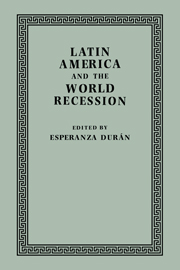Book contents
- Frontmatter
- Contents
- Contributors
- Preface
- 1 The Political Setting: ‘Business as Usual’ or a New Departure?
- Part One The Global Perspective
- 2 Latin America's Financial Crisis: Causes and Cures
- 3 A Comparison of Macroeconomic Strategies in South America
- 4 Latin American and East Asian NICs: Development Strategies Compared
- Part Two Case Studies
- Index
4 - Latin American and East Asian NICs: Development Strategies Compared
Published online by Cambridge University Press: 05 February 2012
- Frontmatter
- Contents
- Contributors
- Preface
- 1 The Political Setting: ‘Business as Usual’ or a New Departure?
- Part One The Global Perspective
- 2 Latin America's Financial Crisis: Causes and Cures
- 3 A Comparison of Macroeconomic Strategies in South America
- 4 Latin American and East Asian NICs: Development Strategies Compared
- Part Two Case Studies
- Index
Summary
The newly industrializing countries (NICs) of Latin America have, until recently, achieved surprisingly high rates of economic growth. Even after the first oil shock in 1973, the Latin American NICs were able to maintain respectable growth rates by increasing their foreign borrowing, and their active demand for Western goods helped to soften the impact of world recession. They were less successful after 1979, however, in adjusting to the second round of inflation, which was accompanied by high real interest rates and increasing protectionism. The problems of the Latin American countries have become more acute in the past two to three years; because OPEC surpluses have virtually disappeared, while at the same time debtor countries have found it increasingly difficult to repay even the interest on previous debt, commercial banks are now both less able and less willing to make fresh loans available. Growth among the Latin American countries has ground to a halt, and their massive external debts appear to threaten the stability of the international financial system.
Yet it would be wrong to attribute these difficulties entirely to the state of the world economy or to seek their solution by calling either for tougher IMF stabilization programmes or for increased international liquidity. The unfavourable world economic environment has merely highlighted problems inherent in the basic economic development path of these countries but previously masked by the extraordinary global prosperity of the early post-war era.
- Type
- Chapter
- Information
- Latin America and the World Recession , pp. 48 - 66Publisher: Cambridge University PressPrint publication year: 1985
- 10
- Cited by



